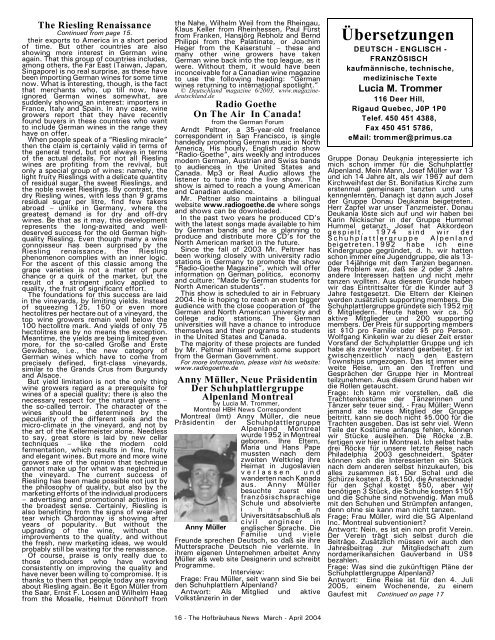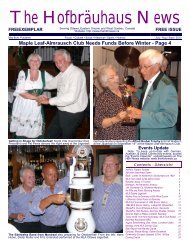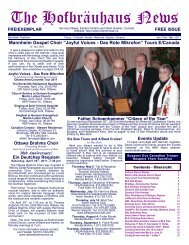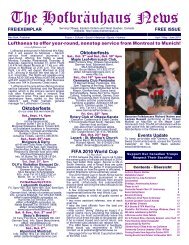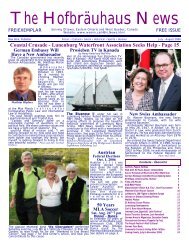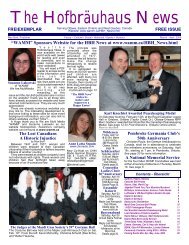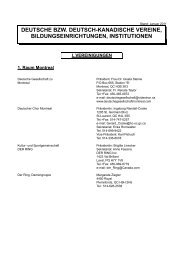Create successful ePaper yourself
Turn your PDF publications into a flip-book with our unique Google optimized e-Paper software.
<strong>The</strong> Riesling Renaissance<br />
Continued from page 15.<br />
their exports to America in a short period<br />
of time. But other countries are also<br />
showing more interest in German wine<br />
again. That this group of countries includes,<br />
among others, the Far East (Taiwan, Japan,<br />
Singapore) is no real surprise, as these have<br />
been importing German wines for some time<br />
now. What is interesting, though, is the fact<br />
that merchants who, up till now, have<br />
ignored German wines somewhat, are<br />
suddenly showing an interest: importers in<br />
France, Italy and Spain. In any case, wine<br />
growers report that they have recently<br />
found buyers in these countries who want<br />
to include German wines in the range they<br />
have on offer.<br />
When people speak of a “Riesling miracle”<br />
then the claim is certainly valid in terms of<br />
the general trend, but not always in terms<br />
of the actual details. For not all Riesling<br />
wines are profiting from the revival, but<br />
only a special group of wines: namely, the<br />
light fruity Rieslings with a delicate quantity<br />
of residual sugar, the sweet Rieslings, and<br />
the noble sweet Rieslings. By contrast, the<br />
dry Riesling wines, with less than 9 grams<br />
residual sugar per litre, find few takers<br />
abroad – unlike in Germany, where the<br />
greatest demand is for dry and off-dry<br />
wines. Be that as it may, this development<br />
represents the long-awaited and welldeserved<br />
success for the old German highquality<br />
Riesling. Even though many a wine<br />
connoisseur has been surprised by the<br />
Riesling renaissance, the Riesling<br />
phenomenon complies with an inner logic.<br />
For the ascent of this classic among the<br />
grape varieties is not a matter of pure<br />
chance or a quirk of the market, but the<br />
result of a stringent policy applied to<br />
quality, the fruit of significant effort.<br />
<strong>The</strong> foundations for this success are laid<br />
in the vineyards, by limiting yields. Instead<br />
of squeezing 125, 150 or even more<br />
hectolitres per hectare out of a vineyard, the<br />
top wine growers remain well below the<br />
100 hectolitre mark. And yields of only 75<br />
hectolitres are by no means the exception.<br />
Meantime, the yields are being limited even<br />
more, for the so-called Große and Erste<br />
Gewächse, i.e., the new category of<br />
German wines which have to come from<br />
precisely defined, first-class vineyards,<br />
similar to the Grands Crus from Burgundy<br />
and Alsace.<br />
But yield limitation is not the only thing<br />
wine growers regard as a prerequisite for<br />
wines of a special quality; there is also the<br />
necessary respect for the natural givens –<br />
the so-called terroir. <strong>The</strong> character of the<br />
wines should be determined by the<br />
peculiarity of the different soils and the<br />
micro-climate in the vineyard, and not by<br />
the art of the Kellermeister alone. Needless<br />
to say, great store is laid by new cellar<br />
techniques – like the modern cold<br />
fermentation, which results in fine, fruity<br />
and elegant wines. But more and more wine<br />
growers are of the opinion that technique<br />
cannot make up for what was neglected in<br />
the vineyard. <strong>The</strong> current success of<br />
Riesling has been made possible not just by<br />
the philosophy of quality, but also by the<br />
marketing efforts of the individual producers<br />
– advertising and promotional activities in<br />
the broadest sense. Certainly, Riesling is<br />
also benefiting from the signs of wear-and<br />
tear which Chardonnay is showing after<br />
years of popularity. But without the<br />
upgrading of the wine, without the<br />
improvements to the quality, and without<br />
the fresh, new marketing ideas, we would<br />
probably still be waiting for the renaissance.<br />
Of course, praise is only really due to<br />
those producers who have worked<br />
consistently on improving the quality and<br />
have never been willing to compromise. It is<br />
thanks to them that people today are raving<br />
about Riesling again. Be it Egon Müller from<br />
the Saar, Ernst F. Loosen and Wilhelm Haag<br />
from the Moselle, Helmut Dönnhoff from<br />
the Nahe, Wilhelm Weil from the Rheingau,<br />
Klaus Keller from Rheinhessen, Paul Fürst<br />
from Franken, Hansjörg Rebholz and Bernd<br />
Philippi from the Palatinate, or Joachim<br />
Heger from the Kaiserstuhl – these and<br />
many other wine growers have taken<br />
German wine back into the top league, as it<br />
were. Without them, it would have been<br />
inconceivable for a Canadian wine magazine<br />
to use the following heading: “German<br />
wines returning to international spotlight.”<br />
© Deutschland magazine 6/2003, www.magazinedeutschland.de<br />
Radio Goethe<br />
On <strong>The</strong> Air In Canada!<br />
from the German Forum<br />
Arndt Peltner, a 35-year-old freelance<br />
correspondent in San Francisco, is single<br />
handedly promoting German music in North<br />
America. His hourly, English radio show<br />
“Radio-Goethe”, airs weekly and introduces<br />
modern German, Austrian and Swiss bands<br />
to audiences in the United States and<br />
Canada. Mp3 or Real Audio allows the<br />
listener to tune into the live show. <strong>The</strong><br />
show is aimed to reach a young American<br />
and Canadian audience.<br />
Mr. Peltner also maintains a bilingual<br />
website www.radiogoethe.de where songs<br />
and shows can be downloaded.<br />
In the past two years he produced CD’s<br />
with the latest songs made available to him<br />
by German bands and he is planning to<br />
produce and distribute more CD’s for the<br />
North American market in the future.<br />
Since the fall of 2003 Mr. Peltner has<br />
been working closely with university radio<br />
stations in Germany to promote the show<br />
“Radio-Goethe Magazine”, which will offer<br />
information on German politics, economy<br />
and culture: “Made by German students for<br />
North American students”.<br />
This show is scheduled to air in February<br />
2004. He is hoping to reach an even bigger<br />
audience with the close cooperation of the<br />
German and North American university and<br />
college radio stations. <strong>The</strong> German<br />
universities will have a chance to introduce<br />
themselves and their programs to students<br />
in the United States and Canada.<br />
<strong>The</strong> majority of these projects are funded<br />
by Mr. Peltner himself with some support<br />
from the German Government.<br />
For more information, please visit his website:<br />
www.radiogoethe.de<br />
Anny Müller, Neue Präsidentin<br />
Der Schuhplattlergruppe<br />
Alpenland Montreal<br />
by Lucia M. Trommer,<br />
Montreal HBH <strong>News</strong> Correspondent<br />
Montreal (lmt) Anny Müller, die neue<br />
Präsidentin der Schuhplattlergruppe<br />
Alpenland Montreal<br />
wurde 1952 in Montreal<br />
geboren. Ihre Eltern,<br />
Maria und Hans Pape<br />
mussten nach dem<br />
zweiten Weltkrieg ihre<br />
Heimat in Jugoslavien<br />
verlassen und<br />
wanderten nach Kanada<br />
aus. Anny Müller<br />
besuchte zuerst eine<br />
französischsprachige<br />
Schule und absolvierte<br />
i h r e n<br />
Universitätsabschluß als<br />
Anny Müller<br />
civil engineer in<br />
englischer Sprache. Die<br />
Familie und viele<br />
Freunde sprechen Deutsch, so daß sie ihre<br />
Muttersprache Deutsch nie verlernte. In<br />
ihrem eigenen Unternehmen arbeitet Anny<br />
Müller als web site Designerin und schreibt<br />
Programme.<br />
Interview:<br />
Frage: Frau Müller, seit wann sind Sie bei<br />
den Schuhplattlern Alpenland?<br />
Antwort: Als Mitglied und aktive<br />
Volkstänzerin in der<br />
16 - <strong>The</strong> <strong>Hofbräuhaus</strong> <strong>News</strong> March - April 2004<br />
Übersetzungen<br />
DEUTSCH - ENGLISCH -<br />
FRANZÖSISCH<br />
kaufmännische, technische,<br />
medizinische Texte<br />
Lucia M. Trommer<br />
116 Deer Hill,<br />
Rigaud Quebec, J0P 1P0<br />
Telef. 450 451 4388,<br />
Fax 450 451 5786,<br />
eMail: trommer@primus.ca<br />
Gruppe Donau Deukania interessierte ich<br />
mich schon immer für die Schuhplattler<br />
Alpenland. Mein Mann, Josef Müller war 13<br />
und ich 14 Jahre alt, als wir 1967 auf dem<br />
Kirchweihfest der St. Bonifatius Kirche zum<br />
erstenmal gemeinsam tanzten und uns<br />
kennenlernten. Danach ist dann auch Josef<br />
der Gruppe Donau Deukania beigetreten.<br />
Herr Zapfel war unser Tanzmeister. Donau<br />
Deukania löste sich auf und wir haben bei<br />
Karin Nickischer in der Gruppe Hummel<br />
Hummel getanzt. Josef hat Akkordeon<br />
gespielt. 1974 sind wir der<br />
Schuhplattlergruppe Alpenland<br />
beigetreten.1992 habe ich eine<br />
Kindergruppe gegründet, d. h. wir hatten<br />
schon immer eine Jugendgruppe, die als 13oder<br />
14jährige mit dem Tanzen begannen.<br />
Das Problem war, daß sie 2 oder 3 Jahre<br />
andere Interessen hatten und nicht mehr<br />
tanzen wollten. Aus diesem Grunde haben<br />
wir das Eintrittsalter für die Kinder auf 3<br />
Jahre festgesetzt. Die Eltern der Kleinen<br />
werden zusätzlich supporting members. Die<br />
Schuhplattlergruppe gründete sich 1952 mit<br />
6 Mitgliedern. Heute haben wir ca. 50<br />
aktive Mitglieder und 200 supporting<br />
members. Der Preis für supporting members<br />
ist $10 pro Familie oder $5 pro Person.<br />
Wolfgang Kinkelin war zu dieser Zeit erster<br />
Vorstand der Schuhplattler Gruppe und ich<br />
habe als zweiter Vorstand gearbeitet. Er ist<br />
zwischenzeitlich nach den Eastern<br />
Townships umgezogen. Das ist immer eine<br />
weite Reise, um an den Treffen und<br />
Gesprächen der Gruppe hier in Montreal<br />
teilzunehmen. Aus diesem Grund haben wir<br />
die Rollen getauscht.<br />
Frage: Ich kann mir vorstellen, daß die<br />
Trachtenkostüme der Tänzerinnen und<br />
Tänzer sehr teuer sind, - Frau Müller: Wenn<br />
jemand als neues Mitglied der Gruppe<br />
beitritt, kann sie doch nicht $5.000 für die<br />
Trachten ausgeben. Das ist sehr viel. Wenn<br />
Teile der Kostüme anfangs fehlen, können<br />
wir Stücke ausleihen. Die Röcke z.B.<br />
fertigen wir hier in Montreal. Ich selbst habe<br />
drei Röcke für unsere letzte Reise nach<br />
Philadelphia 2003 geschneidert. Später<br />
können sich die Interessierten ein Stück<br />
nach dem anderen selbst hinzukaufen, bis<br />
alles zusammen ist. Der Schal und die<br />
Schürze kosten z.B. $150, die Anstecknadel<br />
für den Schal kostet $50, aber wir<br />
benötigen 3 Stück, die Schuhe kosten $150<br />
und die Schuhe sind notwendig. Man muß<br />
mit den Schuhen und Strümpfen anfangen,<br />
denn ohne sie kann man nicht tanzen.<br />
Frage: Frau Müller, wird die SG Alpenland<br />
Inc. Montreal subventioniert?<br />
Antwort: Nein, es ist ein non profit Verein.<br />
Der Verein trägt sich selbst durch die<br />
Beiträge. Zusätzlich müssen wir auch den<br />
Jahresbeitrag zur Mitgliedschaft zum<br />
nordamerikansichen Gauverband in US$<br />
bezahlen.<br />
Frage: Was sind die zukünftigen Pläne der<br />
Schuhplattlergruppe Alpenland?<br />
Antwort: Eine Reise ist für den 4. Juli<br />
2005, einem Wochenende, zu einem<br />
Gaufest mit Continued on page 17


